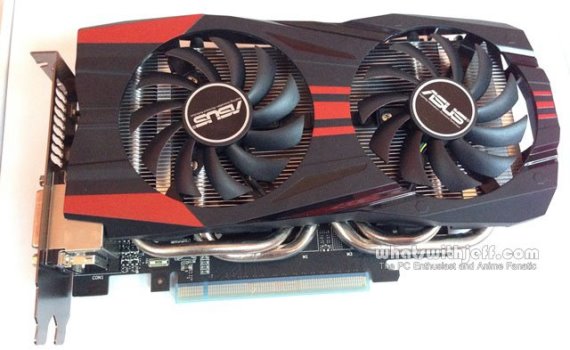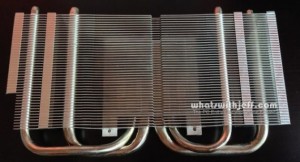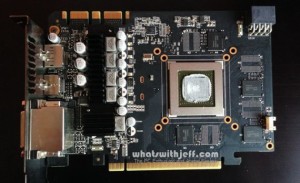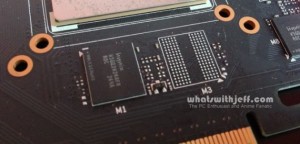Out of the many graphics card currently available on the market, we tend to get lost or become confused on what card should we buy for our gaming needs. Most of the time we are budget constraint and we want to get the most performance out from our money. Today let’s look at the Asus GeForce GTX 760 DirectCU II OC (GTX760-DC2OC-2GD5), an overclocked version of the GeForce GTX 760, and is currently priced somewhere in $2599.99. The non-OC version is around $250, but it seems that the OC version is the more popular choice. In this review, let’s take a closer look at the graphics card itself, and let’s find out its gaming capabilities while playing modern day games.

The Asus GeForce GTX 760 DirectCU II OC is based on a GK104 (28nm) Kepler chip, the same silicon used in the GTX 660 Ti, GTX 670, GTX 690, GTX 680, and ends with the GTX 770. The GTX 760 is the successor of the GTX 660, but it is also faster than the GTX 660 Ti. This just dethroned the GTX 660 Ti, offering more performance, lesser power consumption and a bang for the buck price point. This is often times referred to as the “sweet spot” where you actually get the performance for what you paid for.
The Asus GTX 760 DirectCU II OC has a non-reference design and cooler, which I think is great since it lowers the temperature by around 20% and is more silent compared to the stock design and cooler. It has a factory core speed of 1006MHz to 1072MHz (slightly overclocked), and features a 2GB of GDDR5 memory in a 256-bit memory interface. This graphics card also features GPU Boost 2.0 technology, NVIDIA Adaptive V-Sync and supports DirectX 11.1.
Oh, before I forget, this card also features the NVIDIA GeForce Experience. This software would assist gamers and users to configure their card to achieve the best possible gaming experience they can have. The user interface is quite simple and easy to follow and does not require the skills of a hard core PC enthusiast for you to use this. This also includes the feature called Shadow Play where you can record a video of your game while you’re playing, with just a minimal impact on performance.
The card has a maximum Thermal Design Power of 170W and requires a recommended 550W power supply to run properly. A single card can support 4 displays and I think you can do up to 3-Way SLI with this card. Check out the rest of the specs from the specifications table below.
Asus GeForce GTX 760 DirectCU II OC Specifications
Below is a detailed specification of the Asus GTX760-DC2OC-2GD5 GeForce GTX 760 DirectCU II OC Edition.
| Specifications | Asus GTX760-DC2OC-2GD5 |
|---|---|
| Graphics Engine | NVIDIA GeForce GTX 760 |
| Bus Standard | PCI Express 3.0 |
| Graphics Processor | GK 104 (28nm) |
| CUDA Core (Shaders) | 1152 |
| Raster Operations Pipeline (ROP) | 32 |
| Texture Units | 96 |
| Transistors | 3500M |
| Engine Clock | GPU Boost Clock : 1072 MHz GPU Base Clock : 1006 MHz |
| Memory Size | 2048MB GDDR5 |
| Memory Clock | 1502MHz (6008 MHz Effective) |
| Memory Interface | 256-bit |
| Interface | DVI Output : Yes x 1 (DVI-I), Yes x 1 (DVI-D) HDMI Output : Yes x 1 Display Port : Yes x 1 (Regular DP) HDCP Support : Yes |
| Power Consumption | up to 225W, 8 pin PCIe power required |
| Accessories | 1 x Power cable |
| Software | ASUS GPU Tweak & Driver |
| ASUS Features | DirectCU Series OC Series Super Alloy Power |
| Dimensions | 8.6 ” x 5 ” x 1.5 ” Inch 21.84 x 12.7 x3.81 Centimeter |
The Asus GTX760-DC2OC-2GD5 or the OC Edition has actually similar specifications with the non-OC version or with the Asus GTX760-DC2-2GD5. The only difference is their core clock speeds. The non-OC edition has clock speeds of 980MHz Base clock and 1033MHz Boost Clock. Of course you can overclock the non-OC edition if you want to. But regular users rarely overclock their graphics card.
Packaging and Closer Look
I was quite surprised to see a rather small and simple packaging of the Asus GTX 760 OC. I mean I had an Asus GTX 660 DirectCU II before, and its box was bigger, and you will have to open another black box just to see the card itself. But in the case of the Asus GTX760-DC2OC-2GD5, you will immediately see the card when you open the box, a familiar scenario with a typical motherboard packaging. The box contains the graphics card, a startup guide, a driver CD and a VGA to DVI adapter.
The Asus GeForce GTX 760 DirectCU II OC 2GB

When I first pulled out the Asus GeForce GTX 760 DirectCU II OC out from its protective covering, I was surprise to see a shorter card. It’s even shorter than the Asus GTX 660 DirectCU II. At this point in time, I was thinking that its performance was just on par with the GTX 660 Ti. I actually underestimated the card based on its appearance. But thanks to its shorter body, small form factor users (micro-ATX and even mini-ITX) will enjoy this graphics card.
The Asus GTX760-DC2OC-2GD5 has two DVI ports, one HDMI port and a DisplayPort. Now on the back side, you can clearly see how short the PCB of this card is. The heatsink and the cooler are even longer than the card itself. You will also see the orange metal thingy on the center of the card with a “Direct Power” label on it. Later I’ll explain what it is for. Oh, the blue thing on the PCI and SLI bridge portion are just protective caps, very useful specially if you are currently not using the card or transporting it.
According to NVIDIA’s official specs sheet, the GTX 760 draws its power from two 6-pin power connectors. But the Asus GeForce GTX 760 DirectCU II OC only uses one 8-pin power connector. Other OC models from competing brands use a 6-pin+8-pin power connector. I’m not really sure if the Asus GTX 760 OC is more power efficient compared to the other brands since I have not tested and compared competing brands, but I think it draws lesser power compared to them.
The two 90mm silent fans are attached to the plastic covering of the Asus GTX760-DC2OC-2GD5, and will reveal the long but thin aluminum heat sink with four heat-pipes that is cooling this card.
Notice that only two heat pipes have a direct contact with the GK 104 chip. I think cooling would be further improve it they would not use a direct-heat pipe method, since only two pipes are actually drawing the heat away from the GPU. Or if they use only two very long heat pipes that are interlinked with each other.
Removing the DirectCU II cooler of the Asus GeForce GTX 760 OC would reveal the card itself. As you can see, it has a shorter PCB compared to other GTX series.
After removing the thermal paste, we get a clear picture of the GK104 chip, manufactured in Taiwan. The GK104 is the first 28nm chip produced. On the right hand side you can see the memory chip manufactured by Hynix with model number H5GQ2H24AFR-R0C. They are clock at 1502MHz with a 6008MHz effective speed, also can be overclocked or pushed further.
In the picture above you will see the SLI bridge connector, and a black heat sink that is cooling the voltage regulator. Asus is using Super Power Alloy chips that provide reliable and stable power to the card. It also increases the lifespan of the card by 2.5x compared to the reference card. The picture on the right is showing the chips underneath the black heat sink.
Asus has also added a Direct Power feature on their GTX 760 DirectCU II OC, this ensures stable performance with 17% cooler PCB and a 56% less impedance.
Test Setup
Even though the Asus GTX760-DC2OC-2GD5 has factory overclock settings, you can still even push the card’s clock speeds further, thanks to its superb cooling system and high quality chips built in this card. But in this review, I decided not to overclock this one to show you the real performance of this card out from its box. Not all PC gamers or users, or even PC enthusiasts overclock their hardware.
Below are the following components I used to test the Asus GTX 760 DirectCU II OC:
Operating System: Windows 8 Pro 64-bit
Motherboard: Asus P8H67-M EVO
Processor: Intel Core i5-2500K (Sandy Bridge) slightly OC to 3.3GHz
Memory: 2x 4GB G.Skill RipJaws X and 1x 4GB Corsair Vengeance (total 12GB)
Graphics Card: Asus GeForce GTX 760 DirectCU II OC 2GB
Hard Drive: Samsung 830 128GB for the OS, and Seagate 320GB where the games are installed
Power Supply: Corsair HX650 80 Plus Gold
Case: Cooler Master HAF XM
Case Fans Installed: 3x Cooler Master SickleFlow 120mm, 1x Corsair SP 120 High Performance 120mm (for CPU), 1x stock Cooler Master 200mm fan
Yeah, I know, the system I am using is quite old, but this only proves that if you are still coming from a Sandy Bridge setup with similar specifications, and your major purpose is for gaming alone, then there is no need to upgrade to Ivy Bridge or even Haswell just yet. Just upgrade your graphics card and you will be good to go. Unless otherwise you use your PC for a much more demanding task and multitasking function, or you are planning to buy the latest fastest graphics card on the planet (which may result in CPU-GPU bottleneck), then upgrading to the latest generation of processor and motherboard might be a good investment. But as for gaming alone, it’s not a necessary upgrade.
Also I have done this test in a bright sunny afternoon with no air-conditioning. Temperatures do change depending on the environment, your PC’s cooling system, and even the setup of your PC itself.
I’m also using the software FRAPS and TechPowerUp’s GPU-Z to monitor and record the card’s temperature, min/max/average frames per second, power consumption, fan speed and other statistics. And the driver version I used while doing these test and review is the NVIDIA ForceWare 331.58 or nvlddmkm 9.18.13.3158 for Windows 8 64-bit operating system. You can see a screenshot below. Why did I mention this? The driver is important because it can have an effect on the overall performance of the graphics card. Newer versions of driver are proven to increase the gaming performance compared to the earlier driver version, which by the way is often times buggy.

Benchmarks and Results
For the Asus GeForce GTX 760 DirectCU II OC benchmarks I used 3DMark Advance and the following games: Crysis 3, Crysis 2, Tomb Raider, Medal of Honor, Battlefield 3, and Call of Duty: Modern Warfare 3. I also used the graphics card to play games like Starcraft Wings of Liberty and Heart of the Swarm, Castlevania: Lords of Shadow, Call of Duty Modern Warfare 1 and 2 and Skull Girls. Unfortunately I did not gathered data for those games. But I can say that the Asus GTX 760 DirectCU II OC edition can very much handle those games even in max video settings, and you still get pretty much excellent frame rates even when you turn the V-Sync on.

For the benchmark performance test of the Asus GTX 760 DirectCU II OC, all games where set to their highest possible video settings. In some games you would see it as “Ultra” settings. V-sync was turned off to produce the highest possible frame rates. Of course, I observed tearing or stuttering in some parts of the game while playing but it’s not that really noticeable or annoying.
I also tried playing the same games at the same max settings with the V-Sync on. As expected it lowered the frame rates by a few points, but I was quite surprised to see that I still get decent frame rates even when playing Crysis 3. When I was still using the Asus GTX 660, I could not turn on the V-Sync because it significantly dropped the frame rates making it difficult to play the games.
Oh, for those who are asking what is the V-Sync for? It synchronizes your monitor to your graphics card so that you will not experience tearing or stuttering while playing games. But it will also reduce the frame rates produced (even the performance) of the graphics card just to adjust with the monitor.
As you can see from the graph above the Asus GTX760-DC2OC-2GD5 can very much handle modern day demanding games like Crysis 3. And I bet it can also handle other games like Metro, BioShock Infinite, Far Cry 3 and even the latest Battlefield 4 and Call of Duty Ghost. By the way, the data above is what I got while testing the card. You might get different (but relatively similar) values. When in game, I noticed that frame rates produced go high when you are inside a building or a room, or in a small environment. It decreases while you are in a huge open field or area, or there are lots of graphics and special effects that come out all at the same time.
If you have a higher set of hardware or you are using the latest Ivy Bridge or Haswell Core i7 processors, I bet you will get higher, if not slightly, frame rates result than mine. The Asus GeForce GTX 760 DirectCU II OC edition can handle multiple display setup, up to 4 displays at the same time. When you are playing resource demanding games at a multiple display setup, you might want to get another card and do an SLI configuration; otherwise you will have to lower the game’s video or graphics settings in order to get decent and playable frame rates.
I also tested the card on Square Enix’s latest MMORPG, Final Fantasy: A Realm Reborn. The screenshot above shows that the Asus GTX760-DC2OC-2GD5 can very much handle the game even in maximum 1080p full screen settings. I also tested the card using 3D Mark Advance Fire Strike, Cloud Gate and Ice Storm. I know that the Fire Strike is the only result that really matters but I just ran all the default tests. Below are the results:

I also put to test the performance capability of Asus GTX760-DC2OC-2GD5 by running Fire Strike in Extreme settings; unfortunately the results were not good already. I noticed that the card was already having a hard time rendering the graphics. As you can see from the screenshot below, I only got around 10 to 19 frame rates per second.
Power Consumption and Temperature
Another thing that I like about the Asus GeForce GTX 760 DirectCU II OC is that it’s relatively quiet and cool, thanks to its dual 90mm fans and large heat sink. On idle, the graphics card gets around 33 degrees to 40 degrees Celsius. Remember the room temperature may or will have an effect on the GPU’s temperature, specially your PC’s cooling system. On load, the card starts from 43 degrees Celsius up to 77 degrees Celsius. Those are the temperature I got during my test.
The graph on the left side below shows how the GPU’s temperature, fan speed and power consumption behaves as the GPU load increases. Meanwhile, the graph on the right side below shows how the Core clock, Memory clock and even the Fan speed behaves as the GPU load increases.
Asus GTX760-DC2OC-2GD5 Review Conclusion
Asus is known in producing high quality and top notch hardware and other solution for its consumers. And they have proven it again with the Asus GeForce GTX 760 DirectCU II OC. This graphics card offers a significant performance improvement compared to the GTX 660 and made the GTX 660 Ti outdated. Meanwhile, the overclock model offers a tad or slightly improved performance compared to the reference Asus GTX 760. As I mentioned in the introductory portion, there is only a small difference in the Clock speeds of the reference Asus GTX 760 from that of the OC model. This means that you can still push the card even further. In other test conducted by other PC enthusiasts, it shows that you can still push this card up to around 1200Mhz max GPU clock and 1900MHz max Memory clock.
The Asus DirectCU II cooler also played an important role in the success of this card. Not only that it made the card look great externally, but it also keeps the card cool and quiet, even under full load. If you place your CPU close to your monitor, keyboard and mouse, you wouldn’t be bothered by the noise that the Asus GTX760-DC2OC-2GD5 produce, if there is any.
The only competitor of the GeForce GTX 760 lineup is the AMD Radeon HD 7950, in terms of price and performance. But time and time again, even though the Asus GTX 760 OC is priced slightly higher than the old HD 7950, it still beats it in terms of performance and value. Unfortunately for the HD 7950, it’s the end of the line for this card, since AMD has replaced it with the new R9 series. This makes the GTX 760 unchallenged in the $250 price range.
Now for the retail price of $259.99 (with free shipping), I would say that the Asus GeForce GTX 760 DirectCU II OC is worth of your hard earned money, specially for serious gamers who are in a budget and is looking for a bang for the buck graphics card. The Asus GTX760-DC2OC-2GD5 is a mid-range graphics card with a touch of premium and high-end class GPU that I would recommend to every gamer, system builder and PC Enthusiasts out there.
You can get one or two on Amazon or in Newegg for only $249.99 after a $10 rebate. Prices and promotions are subject to change without notice. It may have gone down by the time you visited this review.


Other Options for You
I am well aware that there are many people who are not fond of NVIDIA’s GeForce GTX graphics card, and would rather opt for an AMD alternative. If you are looking for an AMD graphics card with the same price and performance (at least), the Radeon HD 7950 is your best alternative. Unfortunately it’s the end of the line for that card. AMD has replaced it with the new R9 Series featuring a new set of features. Asus still got you covered with their Asus R9 270X (R9270X-DC2T-2GD5) that retails for $209.99 only. But this one is slower than the Asus GTX 760. If you want a faster card, then get the Asus R9 280x (R9280X-DC2T-3GD5) instead. But it comes with a much higher price tag of $309.99.























Leave a Reply